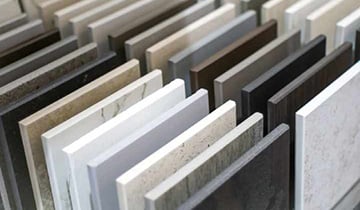6 min read
What’s the best underfloor heating to use in kitchens?
Kitchens are usually the most used living spaces in any home and are often not just for cooking but for entertaining in too. For the ‘heart of the...
5 min read
 Ruben Reynolds
:
Jan 24, 2022
Ruben Reynolds
:
Jan 24, 2022

When it comes to underfloor heating, it is much more common to heat tile or stone floors than wood, carpet or vinyl. So, you can imagine why one of the most popular questions we get asked is ‘what’s the best underfloor heating system for a tile or stone floor?’
Before you fully commit to buying an underfloor heating system that will have a beautiful tile or stone floor laid over it, read this blog post. It contains some helpful tips and what to consider before going full steam ahead and it could save you some time, money and aggravation.
If you haven’t got the 4 minutes and 23 seconds now to continue reading to the end, bookmark the page and come back later. Alternatively, get in touch via our contact page and one of our team will be on hand to answer any questions you may have.
There are so many reasons why installing underfloor heating makes sense. No matter if it’s electric or wet underfloor heating, they both provide unquestionable benefits. We won’t go into all of the detail because we’ve covered those in depth in other articles on our heating blog. However, here’s some top benefits to give you a flavour:
Comfortable heat: Unlike traditional central heating, underfloor heating helps humidity to be kept in the air and then the heat is distributed evenly throughout the room which creates more comfortable heat.
Clean design: With no radiators the walls, there’s no limitation on where you can place furniture which gives you more design freedom.
Zone control: By creating heating zones with underfloor heating you’ll conserve energy because you are only heating up the room you want to and not the entire house.
Better efficiency: Electric underfloor heating, as an example, operates at much lower temperatures and is 100% efficient at point of use. Each joule of energy paid for is used at the exact point where the heat it is needed.
Environmental credentials: Underfloor heating uses less energy than traditional systems. In particular, electric heating is favoured in the soon to be released SAP 10 calculations. Why? Because electric produces much less carbon emissions compared with gas alternatives.
Health benefits: Yep. Underfloor heating can also help to create healthier environments which benefit your health. Want to know why? Read the ‘Can underfloor heating boost your health?’ blog post.
One of the main benefits of using a tiled floor with underfloor heating is that they are a brilliant natural conductor of heat and comfortable heat is spread evenly and quickly, meaning you’re less likely to get cold spots in the room. Luxury tiles give a great feel to any room, and there’s lots of options out there.
Porcelain and Ceramic tiles are the most popular types of floor tile and in many cases a more affordable compared to stone floor tiles. Tile thickness has little impact on heat output, but sometimes thicker finishes (up to 20mm) can increase the heat up time whilst the heat transfers through, but it will also hold the heat for longer. Most internal floor tiles are approximately 10mm – 12mm thick which is ideal for underfloor heating.
If you’re thinking of going down the natural stone route, the vast majority of stone suppliers will state which options are best for underfloor heating, but a couple of examples would be;
There are a few things to consider which will help you form your opinion on what is going to be the best underfloor heating system for your project.
What are the risks with tile or stone floors?
The main risk with a tile or stone floor is cracking of the tile itself or the grouted joints. Reasons for this can include temperature variations in the tile and/or substrate due to heating and cooling cycles and even by seasonal temperature changes.
Another risk when installing a tiled floor over underfloor heating is the risk of accidentally snagging the heating cable with the trowel when applying adhesive ready for the tile to be laid on.
Finally, you must ensure that the subfloor that you are installing your underfloor heating on is level. This is particularly important to ensure that the heat is distributed consistently and not effected by differing thicknesses of adhesive cover.
You can mitigate these risk factors by making sure your installer uses a flexible cement based tile adhesive and grout and that they make adequate provision for expansion and contraction (movement joints).
Heating and decoupling systems
A more recent innovation with electric underfloor heating is the heating and decoupling membrane system. These types of systems are available brands such as Schluter, Warmup, and our good selves. The decoupling membrane has been designed to prevent cracking, lifting and delamination of tiled floors. The membrane acts like a decoupling layer allowing the tiled surface to move independently from the substrate. This helps to mitigate any potential damage to a tiled floor caused by expansion and contraction, whilst at the same time, holding the heating cable in place via dimples (or studs). How the heating cable is held in place by the decoupling membrane can vary between brands.
These heating and decoupling systems also allow for different heating outputs by changing the spacing of the heating cable. For example, using the ThermoSphere Membrane system, you can use a two-dimple spacing for an output of 195W/m2 (ideal for wet rooms) or a three-dimple spacing for an output of 130W/m2 (great for well-insulated buildings).
Another great benefit of a heating and decoupling system is protecting the heating cable. This is because the heating cable is pressed in-between dimples (or studs) causing any potential damage caused by a heavy hand using a trowel to be mitigated.
Finally, the majority of heating and decoupling systems have waterproofing properties and when combined with tanking kits they protect the substrate from water which makes them ideal for wet rooms.
Mesh mat (heating mat) systems
The traditional mesh mat system such as, Heat Mat’s Heating Mats, Flexel’s ECOFLOOR Mats, Warmup’s StickyMat System and our very own ThermoSphere Mesh are all suitable for tile and stone floor finishes. These types of system have been around for longer than their heating and decoupling membrane cousins.
The majority of these types of heating mat systems are installed wire side up. The heating cable comes pre-spaced on top of the mesh and here lies a potential challenge for the installer. When spreading the flexile tile adhesive (or levelling compound) over the mesh mat underfloor heating system there is a higher risk of damaging the heating cable with the trowel (if you aren’t careful). The slightest bit of damage could cause the underfloor heating system to fail either when it is first switched on or during the years following. To help reduce this risk look for mesh systems that are installed wire side down so the mesh which better protects the heating cable from accidental damage.
Another important point
You’ll find many tiles shops supply electric underfloor heating and they can advise you on different systems, heat outputs and any accessories (e.g. insulation) you’ll need for your project. If you want to know more specifically about underfloor heating and wet rooms check out ‘Why electric underfloor heating is ideal for wet rooms…’
Hopefully, this blog post has given you some pointers when it comes to underfloor heating and tiled floors and don’t forget that our team are on hand to help answer any further questions that you may have. Just head on over to the contact us page to start the conversation.

6 min read
Kitchens are usually the most used living spaces in any home and are often not just for cooking but for entertaining in too. For the ‘heart of the...

9 min read
If you are researching the feasibility of electric underfloor heating for your home, you may see a lot of examples that simply talk about underfloor...

11 min read
As a British manufacturer of electric underfloor heating, we often get asked ‘What’s the best electric underfloor heating system to use?’. Sounds...